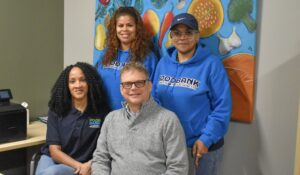A software system developed by Blue Ridge Area Food Bank is helping food banks not only push more nutritious food out the door, but also prove that it’s nutritious.
The Nourish system, developed in partnership with a local university, lets food banks track the nutritional quality of their food inventory using evidence-based guidelines adopted by Feeding America. Using the system, food banks can set and meet higher nutritional standards, while also validating their progress toward higher quality food.
Following agreed-upon guidelines is important as healthcare providers increasingly rely on community-based organizations like food banks to help them meet the needs of patients struggling with diet-related diseases. Doctors are hard-pressed to refer patients to charitable food providers if they can’t guarantee that those patients will receive healthy food.

“For outside stakeholders like donors and healthcare partners, our ability to present the data and give them something visual to understand the profile of our inventory is incredibly important,” said Michael McKee, CEO at Va.-based Blue Ridge Area Food Bank. “It’s going to become all the more important as healthcare payers and providers are asked to invest more in human service organizations like food banks. We can’t just say, ‘Well, our food meets nutritional standards, trust us.’”
Nourish adheres to the Healthy Eating Research guidelines introduced in 2020, which created a standard framework for the charitable food system to rank nutrition (Food Bank News wrote about that here). The HER guidelines most closely follow the nutrition ranking system developed by SWAP (Supporting Wellness at Pantries), employing the same color-coded tiers of choose often (green), choose sometimes (yellow), or choose rarely (red).
Nourish can be thought of as a way to operationalize SWAP – which was originally developed for use by pantries – and run it at scale. It uses the same visual imagery of a stoplight to automate the scoring of individual food items, and incorporates the scores into a food bank’s inventory management system, giving a full picture of the amount of nutritious food in inventory at any one time.
Once the initial process of nutrition-scoring a food bank’s inventory is complete, the ongoing day-to-day maintenance is minimal. “The hallmark of Nourish is its operational efficiency,” said Dr. Michelle Hesse, RD, Assistant Professor at James Madison University, which helped spearhead the creation of Nourish.
Since using Nourish, Blue Ridge Area Food Bank has increased the amount of green and yellow food it distributes. Green and yellow items represented 98% of the 11 million pounds the food bank distributed in the first half of FY2024, a 30% increase over 8.5 million pounds during the same time in FY2023. At the same time, the percentage of food ranked red decreased from 4.26% to 2.06%, while the amount of fresh produce went up by nearly 20% (see chart above).
Blue Ridge Area Food Bank nutrition-scores all the food it receives from the USDA, as well as purchased food, all produce, and donated items that come in large quantities. The only foods it does not score are random, mixed-salvage items. For Food Sourcing Manager Greg Knight, having a science-based definition of nutrition has made it easier to make decisions about food purchases and donations. “I can be confident when I choose an item and say, ‘This is green,’” he said.
Over the summer, Va.-based Fredericksburg Regional Food Bank began using Nourish, and two other Va.-based food banks – Feeding Southwest Virginia and Foodbank of Southeastern Virginia and the Eastern Shore – are in the process of being onboarded. Hesse said she hopes to have all seven food banks in Virginia using Nourish by 2025, and would love to see food banks in other states adopt it as well. The Nourish software costs about $2,500 to get up and running, she said.
McKee expects that Nourish will become increasingly important to Blue Ridge Area Food Bank – and to food banks everywhere – as they strike up more partnerships with healthcare providers. “Even for basic-level screenings and referrals, they’re going to want to understand that they’re actually referring patients into programs that are providing food that will indeed support their health,” he said.
And if Medicaid reimbursement for food becomes a reality, state agencies are going to require some verification that the food they’re paying for meets scientifically established standards to support human health. He noted, “When we can actually show them the data and give them the assurance that they need, and that’s just going to become more and more the expectation within the healthcare sector.” – Chris Costanzo
Like what you’re reading?
Support Food Bank News








